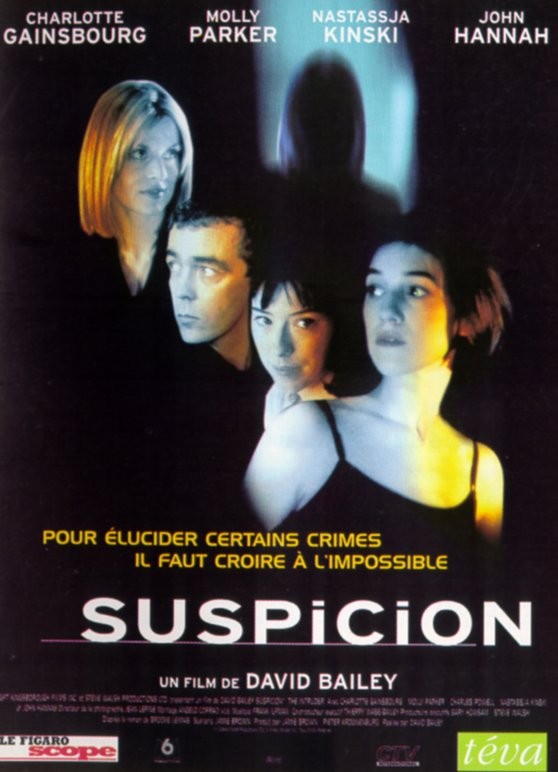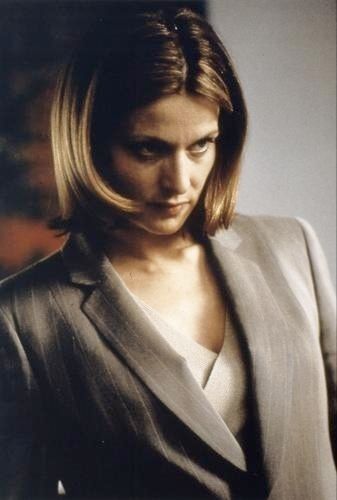Dir: David Bailey
Star: Charlotte Gainsbourg, Charles Powell, Nastassja Kinski, John Hannah
a.k.a. Suspicion
“Everything was bad – the producers were awful. The actresses – well, you couldn’t have had a bigger contrast. Charlotte Gainsbourg was absolutely marvellous, word perfect, so professional. Nastassja Kinski, on the other hand, was a nightmare. The whole experience – have you seen Swimming with Sharks? It was just like that.”
— David Bailey
 Part noir thriller, part psychological drama, part ghost story and part science fiction, this deserves some credit for trying to be so many things, even if you’d be hard-pushed to argue it’s completely successful at any of them. Catherine (Gainbourg) meets Nick (Powell) at a gallery,. and the two begin a relationship which leads to her moving in to his apartment. However, Nick’s past is somewhat murky, including a previous wife, Stella, who was apparently murdered in their apartment and about whom he doesn’t like to talk. There’s also the question of his relationship with the downstairs neighbor Badge Muller (Kinski), which may not have ended with the arrival of the newcomer, though she takes Catherine under her wing, employing her as an assistant in Badge’s art brokerage. However, Catherine’s biggest issue is that someone appears to be entering the apartment and interfering with things, even after the locks are changed, though she’s unable to find any evidence with which she can convince Nick. Instead, he reckons she is coming down with the same kind of delusions that plagued Stella in the time leading up to her death. Though considering his wife was then murdered by an unknown intruder, you’d think he might take the warning signs Catherine is seeing a bit more seriously.
Part noir thriller, part psychological drama, part ghost story and part science fiction, this deserves some credit for trying to be so many things, even if you’d be hard-pushed to argue it’s completely successful at any of them. Catherine (Gainbourg) meets Nick (Powell) at a gallery,. and the two begin a relationship which leads to her moving in to his apartment. However, Nick’s past is somewhat murky, including a previous wife, Stella, who was apparently murdered in their apartment and about whom he doesn’t like to talk. There’s also the question of his relationship with the downstairs neighbor Badge Muller (Kinski), which may not have ended with the arrival of the newcomer, though she takes Catherine under her wing, employing her as an assistant in Badge’s art brokerage. However, Catherine’s biggest issue is that someone appears to be entering the apartment and interfering with things, even after the locks are changed, though she’s unable to find any evidence with which she can convince Nick. Instead, he reckons she is coming down with the same kind of delusions that plagued Stella in the time leading up to her death. Though considering his wife was then murdered by an unknown intruder, you’d think he might take the warning signs Catherine is seeing a bit more seriously.
The viewer has probably worked out where this has going before the characters do, not least because of what could be seen as a fatal misstep in the structure, since it opens with Catherine confessing to the police that she murdered Stella, only to be told that it had already happened years previously. It’s likely too much of a reveal, and is not long before you can fill in the blanks. Although, if that isn’t enough, the film then wheels on Hannah as another neighbor, a conveniently expository computer programmer who is also – as we all are, apparently – an expert in quantum physics, and can explain to Catherine about wormholes in space, the Philadelphia Experiment and its modern-day equivalent, the Montauk Project. Turns out that, for some reason which is never explained, the apartment is one such wormhole, allowing Catherine and Stella to move through time and interact, at least to a certain degree, with each other. Neither are exactly happy about this unparalleled opportunity, however. Me, I’d be buying lottery tickets and investing in Google stock.
 If the plot is the weakest element, the performances help paper over its cracks and give it more credibility than it likely deserves. Gainsbourg is particularly good, and there’s an escalating sense of paranoia, mostly from her point of view. The film also looks solid, with the apartment complex, where the bulk of it takes place, almost a character on its own. The stylish aspects are not much of a surprise, since director Bailey is much more well-known as a photographer, particularly for his stark, black-and-white portraits from the sixties [he inspired the lead character in Antonioni’s Blowup, which starred Gainsbourg’s mother, Jane Birkin]. This may have been his only feature; the IMDb mentions a 1977 film, Paperback, with Helmut Berger and John Hurt, but I’ve been unable to find out any information, even whether this was a short or a full-length movie. Last year, he told Paris-Match, “Nastassja Kinski was never there!” and Bailey doesn’t appear to have enjoyed the experience, as the quote on top of this article should make abundantly clear, adding “What went wrong was Canada, mainly – don’t ever shoot a film in Montreal if you can help it.”
If the plot is the weakest element, the performances help paper over its cracks and give it more credibility than it likely deserves. Gainsbourg is particularly good, and there’s an escalating sense of paranoia, mostly from her point of view. The film also looks solid, with the apartment complex, where the bulk of it takes place, almost a character on its own. The stylish aspects are not much of a surprise, since director Bailey is much more well-known as a photographer, particularly for his stark, black-and-white portraits from the sixties [he inspired the lead character in Antonioni’s Blowup, which starred Gainsbourg’s mother, Jane Birkin]. This may have been his only feature; the IMDb mentions a 1977 film, Paperback, with Helmut Berger and John Hurt, but I’ve been unable to find out any information, even whether this was a short or a full-length movie. Last year, he told Paris-Match, “Nastassja Kinski was never there!” and Bailey doesn’t appear to have enjoyed the experience, as the quote on top of this article should make abundantly clear, adding “What went wrong was Canada, mainly – don’t ever shoot a film in Montreal if you can help it.”
On the downside, the film reminded me of why I hate jazz music, especially the noodly, saxaphoney stuff which gets heavy play here – apparently, the streets of Montreal are filled with itinerant sax players, delivering free-form warblings, even in the depth of winter. Nick, in particular, is the kind of asshole I would actively cross the street to avoid, so Catherine’s rapid falling for him never rings true, especially considering his ongoing refusal to believe a word she says. Kinski, as the oddly-named “Badge” [seriously, I’ve never heard of anyone called that. It is short for Badger?] slides easily enough into the role of alluring femme fatale, though her role seems mostly to act as a threatening red herring for the heroine. The atmosphere generated by Bailey is clearly influenced by another 60’s icon, Roman Polanski’s Rosemary’s Baby, which may offer an additional hint at the reasons for Kinski’s casting; Bailey and Polanski certainly know each other, Bailey believing he introduced Polanski to Sharon Tate. There’s also a hint of Brian De Palma, in the psycho-sexual tension, and multiple sets of twins which pop up in the plot.
The director’s self-assessment of the film has degraded over time, but has never been particularly favorable. ‘Even before its release, he said, ‘It’s not a great film. It’s just O.K. I’ve seen worse.” But after a decade had passed, in 2010, he was considerably more acerbic. “It’s the worst thing I have ever done in my life. All they were interested in was that, through me, they could get Nastassja Kinski and Gainsbourg. It was awful. I don’t think I have ever watched it.” I wouldn’t go that far, though I can certainly see why it was never released theatrically, going straight to video. But as something to curl up with on the sofa, clutching a hot chocolate to counter the chilly setting [both externally and emotionally], I am more inclined to agree with Bailey’s original statement. I, too, have seen worse.